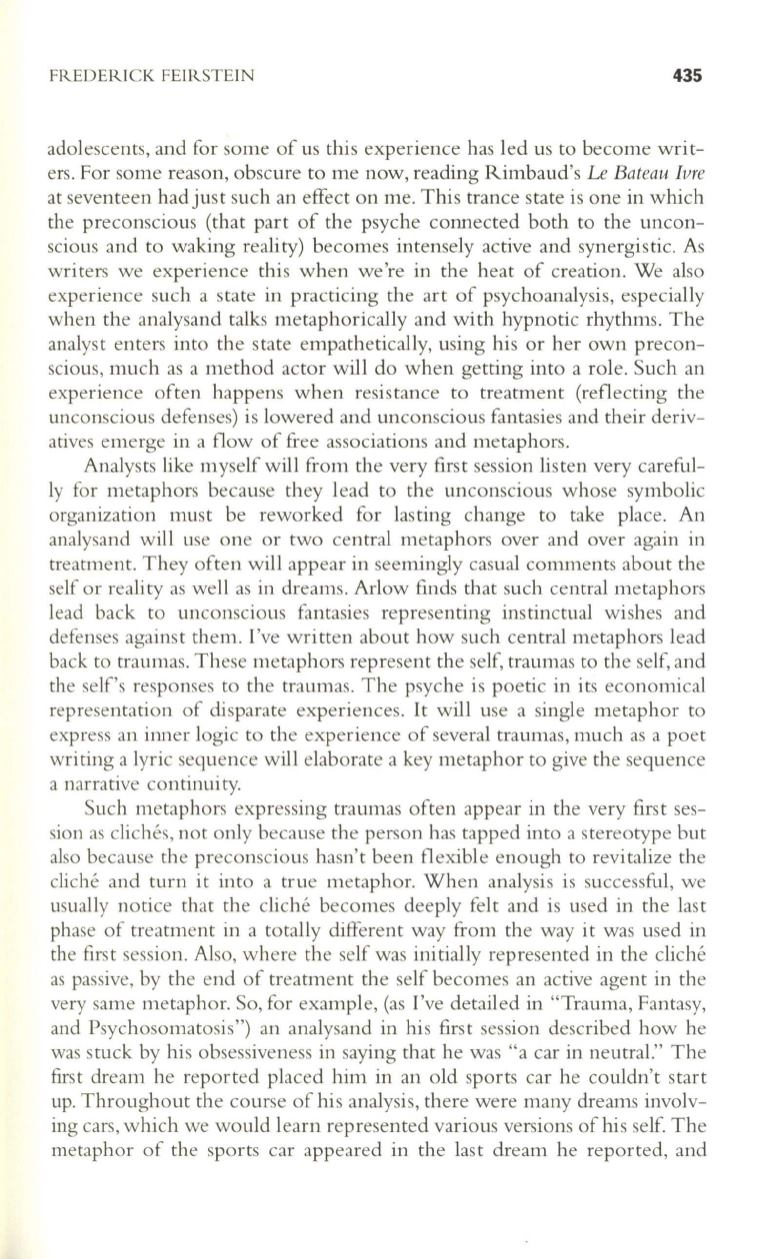
FREDERICK FEIRSTEIN
435
adolescents, and for some of us this experience has led us to become writ–
ers. For some reason, obscure to me now, reading Rimbaud's
Le
Bateau Ivre
at seventeen had just such an effect on me. This trance state is one in which
the preconscious (that part of the psyche connected both to the uncon–
scious and to waking reality) becomes intensely active and synergistic. As
writers we experience this when we're in the heat of creation. We also
experience such a state in practicing the art of psychoanalysis, especially
when the analysand talks metaphorically and with hypnotic rhythms. The
analyst enters into the state empathetically, using his or her own precon–
scious, much as a method actor will do when getting into a role. Such an
experience often happens when resistance to treatment (reflecting the
unconscious defenses) is lowered and unconscious fantasies and their deriv–
atives emerge in a flow of free associations and metaphors.
Analysts like myself will from the very first session listen very careful–
ly for metaphors because they lead to the unconscious whose symbolic
organization must be reworked for lasting change to take place. An
analysand will use one or two central metaphors over and over again in
treatment. They often will appear in seemingly casual comments about the
self or reali ty as well as in dreams. Arlow finds that such central metaphors
lead back to unconscious fantasies representing instinctual wishes and
defenses against them. I've written about how such central metaphors lead
back to traumas. These metaphors represent the self, traumas to the self, and
the self's responses to the traumas. The psyche is poetic in its economical
representation of disparate experiences. It will use a single metaphor to
express an inner logic to the experience of several traumas, much as a poet
writing a lyric sequence will elaborate a key metaphor to give the sequence
a narrative continuity.
Such metaphors expressing traumas often appear in the very first ses–
sion as cliches, not only because the person has tapped into a stereotype but
also because the preconscious hasn't been flexible enough to revi talize the
cliche and turn it into a true metaphor. When analysis is successful, we
usually notice that the cliche becomes deeply fel t and is used in the las t
phase of treatment in a totally different way from the way it was used in
the first session. Also, where the self was ini tially represented in the cliche
as passive, by the end of treatment the self becomes an active agent in the
very same metaphor. So, for example, (as I've detailed in "Trauma, Fantasy,
and Psychosomatosis") an analysand in his first session described how he
was stuck by his obsessiveness in saying that he was "a car in neutral." The
first dream he reported placed him in an old sports car he couldn't start
up. Throughout the course of his analysis, there were many dreams involv–
ing cars, which we would learn represented various versions of his self. The
metaphor of the sports car appeared in the last dream he reported, and


